2012 VOLKSWAGEN GOLF MK6 weight
[x] Cancel search: weightPage 133 of 516
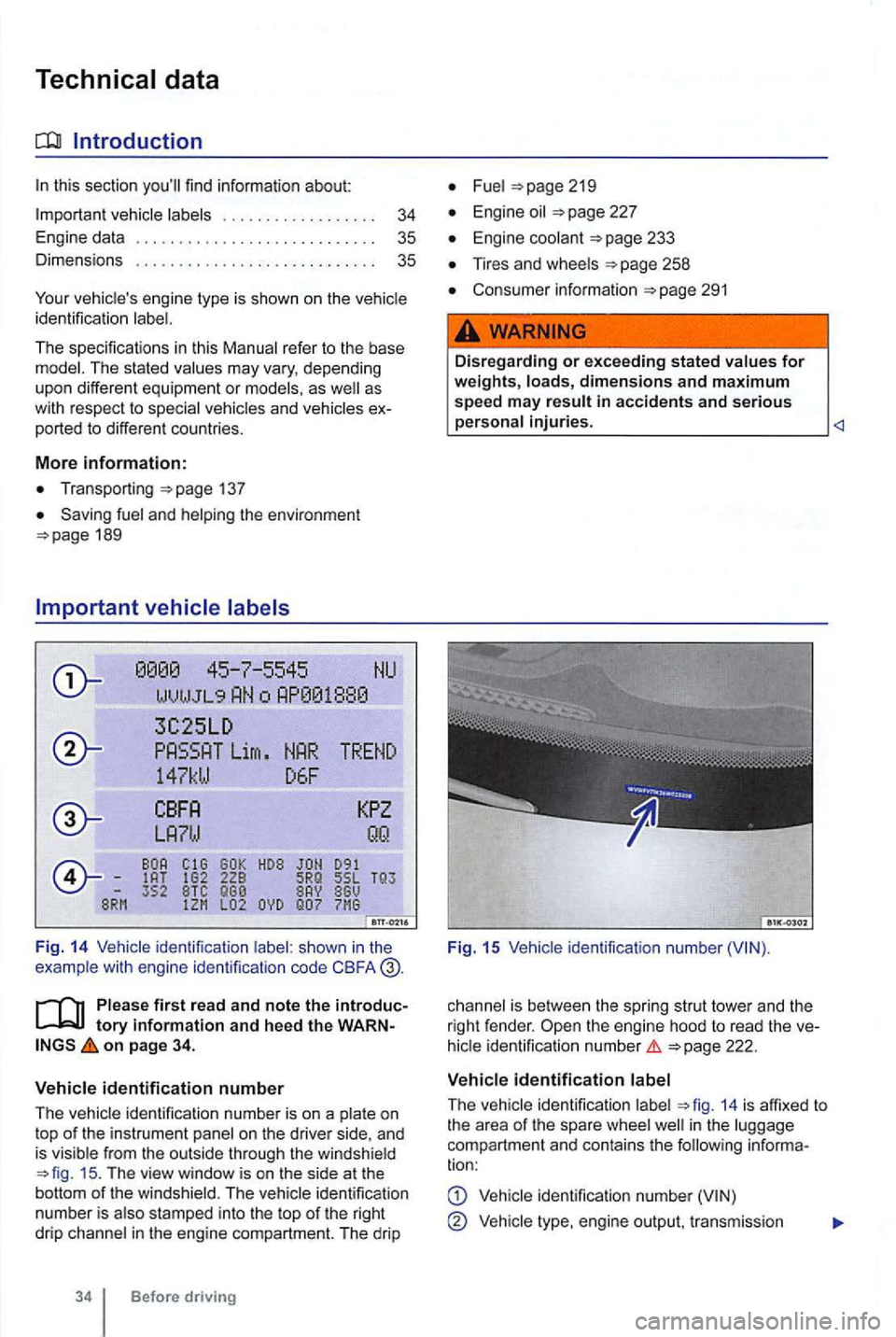
Introduction
137
Saving fuel and helping the environment
WVlJ J L9
3C25LD
Lirn
147kW D6F
352 BTC
F ig . 14 Vehicle identification shown in the
example wit h engine identificalion code CBFA
first read and n ote the int roductory information and h eed t he WA RNon page 34.
V ehicle id entification numb e r
The
ide ntifica tion number is on a and
is visib le from the outside through the windshield 15 . The view window is on the side at the
botto m of the winds hie ld. The identification
n umber is also stamped into the top of the right
drip channel in the engine compartment. The drip
Before driving
Fuel
Engine oil
Engine coolant
Tires and wheels
Consumer informatio n 291
.
Dis regarding or exceeding s tat ed values for weights, loads, dimensions and m aximum speed m ay result in accidents and s erious ____________________
Fig. 15
is bet ween the spring strut tower and the
right fende r.
ident ificat io n numbe r
ide ntification 14 is affixed to
t h e a rea of the spare well in the comp artment an d contains the following informa
tion:
identification number
Vehicl e engine ou tput, tr ansmission
Page 157 of 516
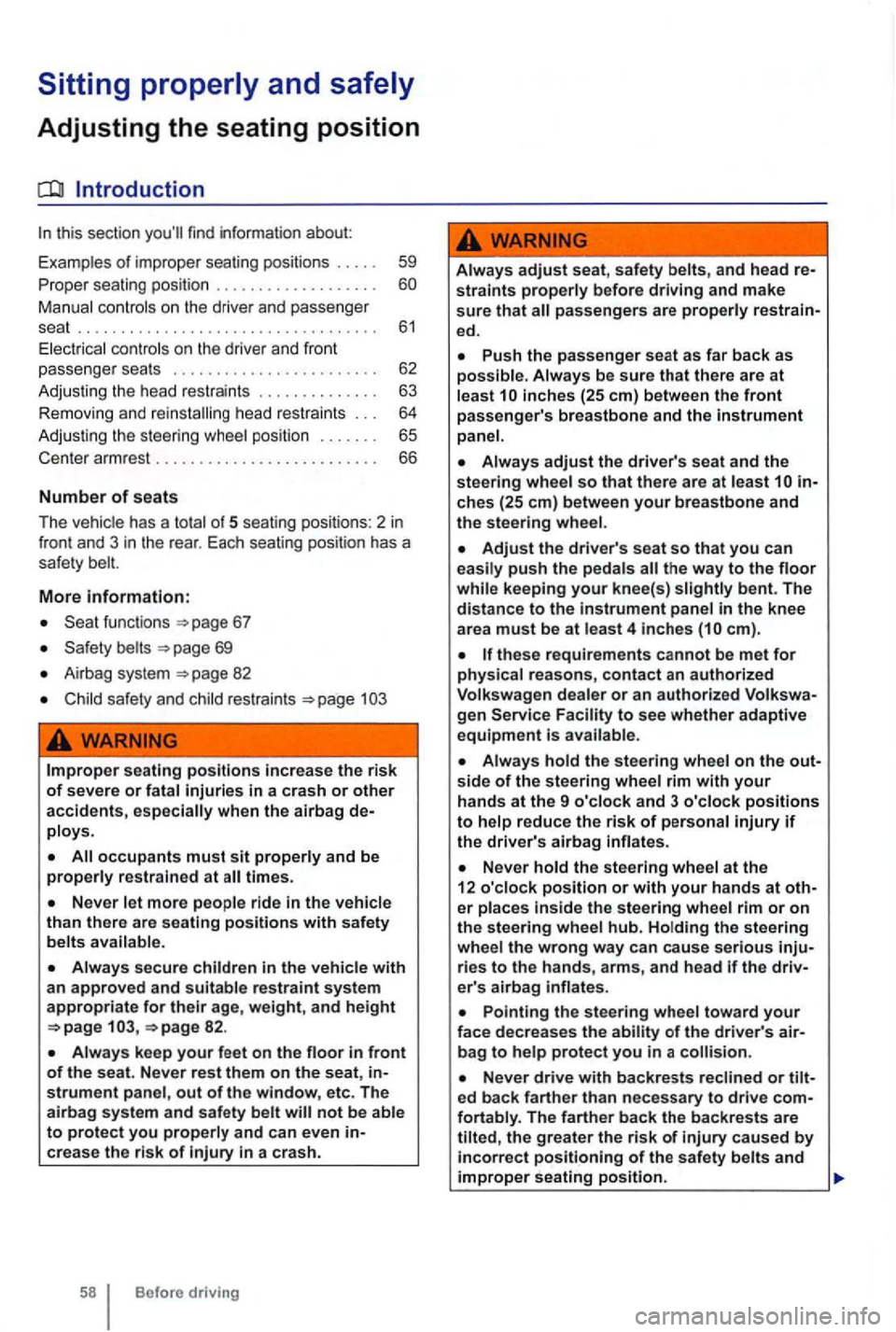
Adjusting the seating position
Introduction
this section find inf ormation about:
Examp les
of improper seat ing pos itions . . . 59
Pr ope r seating position . . . . . . . . . . . . .
Manual contr ols on the driver and passe nger
seat . . . . . . . . . . . . . . . . . . . . . . . . . . . . . . . . . . . 61 Ele ctrica l co ntr ols o n the driver and front
passenger seats . . . . . . . . . . . . . . . . . . . . . . . . 62
Adj ustin g
the head restra ints . . . . . . . . . . . . . 63
R emoving and re in stalling head restraints . . . 64
Adj usting the stee
ring whee l position . . . . . . . 65
Cen te r armrest . . . . . . . . . . . . . . . . . . . . . . . . . . 66
Number of seats
Th e vehicle
has a t otal of 5 seat ing posit ions: 2 in front and 3 in the rea r. Eac h seating pos ition has a
safety belt.
More information:
funct ions 67
page 69
Ai r ba g syste m 82
safety and child restraints
WARNING
Improper seat ing pos itions increase the risk of severe or fatal injuries in a crash or other accidents,
times .
Never
Always secure children in the vehicle with a n approved and suitable restraint system appropriate for their age, weight, and height 82 .
Always keep your feet on the in front of the seat. Never rest them on the seat,
Always adjust seat , safety belts, and head straints properly before driving and make sure that
inches (25 em) betw een the front pa ssenger' s breastbone and the in strument panel.
ches (25 em) between your breastbone and the steering wheel.
Adjust the driver's seat so that you can push the pedals while keeping your knee(s) slightly bent. The
di stance to the instrument panel in the knee
a rea must be at least 4 inche s
these requirements cannot be met for physical reason s, contact an authorized
Volk swagen dealer or an auth orized gen Facility to see whether adaptive equipment is avai la bl e.
Always hold the steering wheel on the side of the steering wheel rim with your hands at the 9 o'clock and 3 o'clock positions to help reduce the risk of personal injury if the driver's airbag inflates .
Never hold the steering whee l a t the
12 o'clock position or with your hands at e r places inside the steering whee l rim or on the steering wheel hub. Holding the steering wheel the wrong way can cause serious rie s to the hand s, arm s, and head if the
Pointing the steer ing whe el t oward your face dec reases the of the driver's bag to h elp protect you in a
Never drive with backrest s reclined or ed back farthe r than necessary to drive
Page 170 of 516
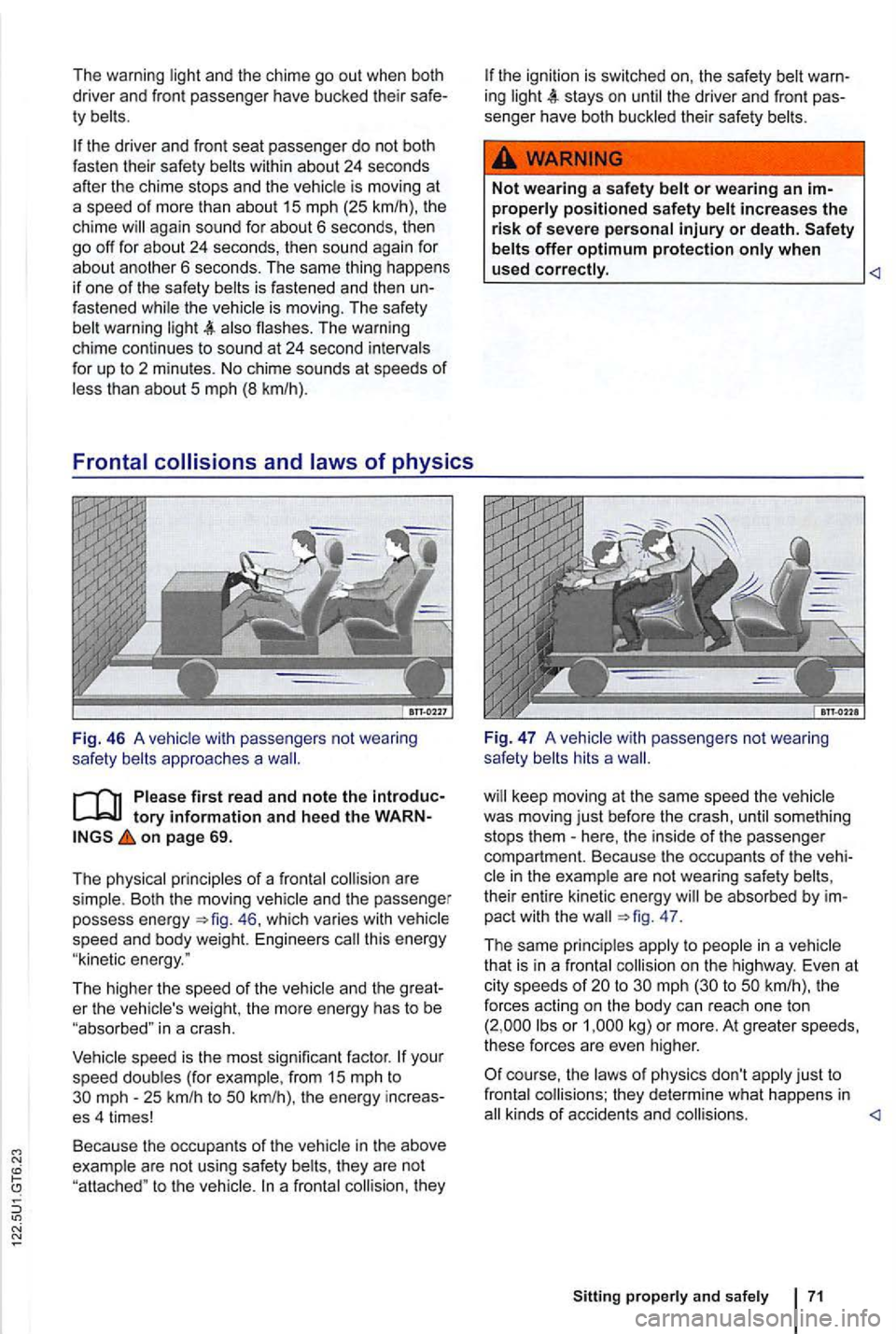
and the chime go out when both
driver and f ront passenger have bucked their ty
again sound for about 6 seconds, then go off for abo ut 24 seconds, then sound aga in for about anolher 6 seconds. The same thing happens
i f one of the safety fastened warning
of physics
Fig. 46 A vehicle with passengers not wearing safety
on page 69.
The physical principles of a frontal are
s imple . Both the moving vehicle and the passenger
possess energy 46, which varies with
er the vehicle 's weight, th e more energy h as to be "abso rbed" in a c rash.
speed is the most significan t factor .
they are not "attached " to the
increases the risk of severe personal injury or death.
with passengers not wea ring
safety
keep moving at the same speed the ve hicle was moving just befo re the cras h,
in the example are not wearing safety their entire kinetic energy pact with the 47.
The same principles on the highway. Even at
c ity speeds of 20 to 30 mph (30 to 50 km/h), the
fo rces acting on the body can reach one ton
(2 ,000 o r kg) or more. At greater speeds,
these forces are even higher.
of physics don't j ust to frontal they determine what happens in kinds of accidents and
Page 184 of 516
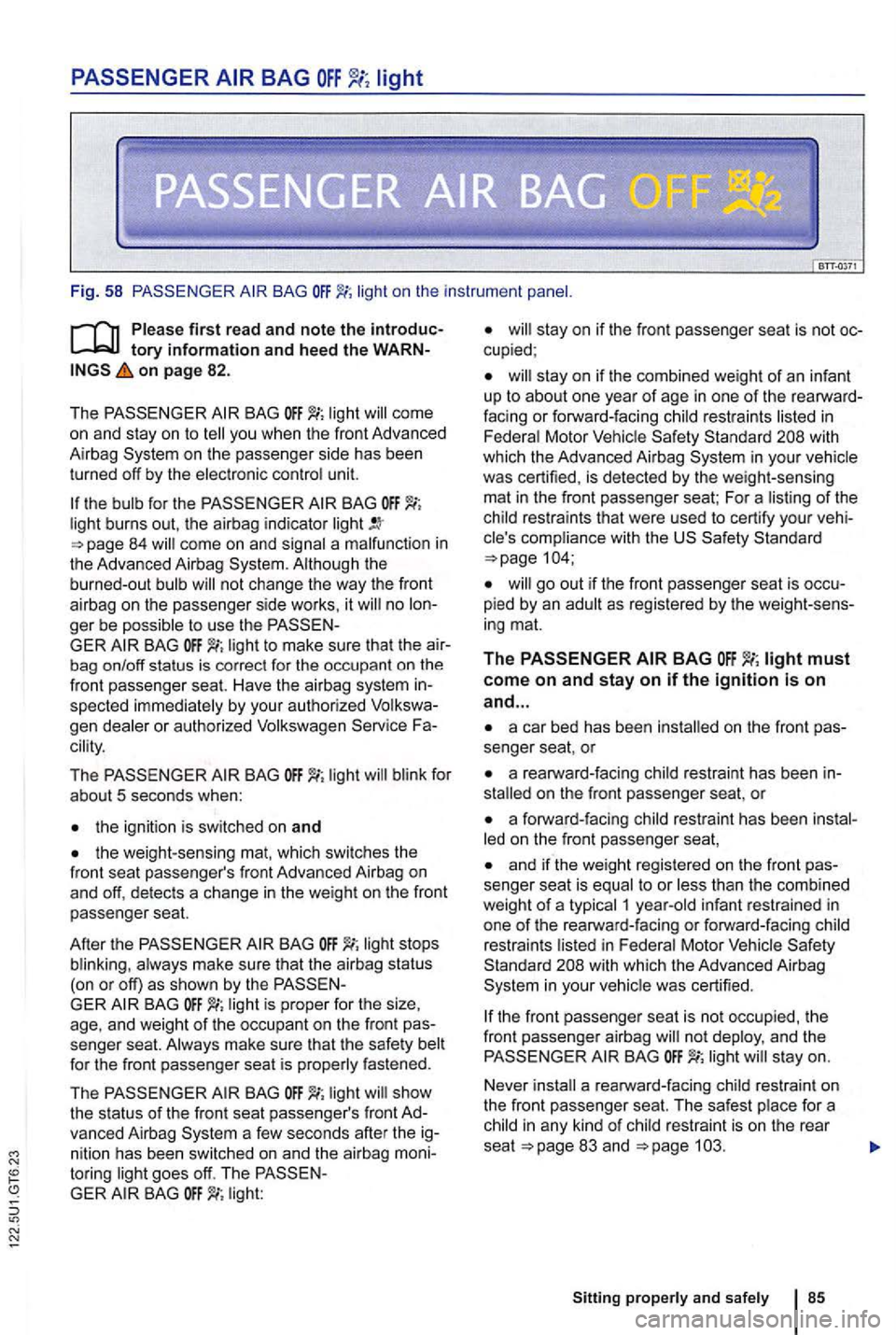
Fig. 58 BAG lig ht o n the instrument
on page 82 .
T he
BAG
on the passenge r side has been
turned off by the electronic con trol unit.
th e bulb for the BAG light burns out, th e airbag indicator come on and signal a malfunction in
the Advanced Airbag
no ger be possible to use the BAG light to make sure that th e bag on/off status is correc t fo r the occupant on the
front passenger seat. Have the air bag system spected immediate ly by your auth orized gen dea le r or authorized Volkswagen cility .
The BAG light blink for
about 5 seconds when:
BAG always make sure that the airbag status
(on or off) as shown by the
GER BAG light is proper for the size ,
age , and weight of the occupant on the fron t
light show
the status of the front seat passenger's front vanced Airbag
toring light goes off. The GER light:
stay on if the combined weight of an infant
up to about one year of age in one of the facing or forward- fac ing restraints listed in
Federal Motor Vehicle with
which the Advanced Airbag in your vehicle
was certified , is detected by the weigh t-sensing
mat in the front passenger seat; For a lis ting
of the
child restraints th at were used to certify your
go out if the front passe nger seat is
ing mat.
The must come on and stay on if the ignition is on
and ...
a car bed has been on the front senger seat, or
a rearward-facing child restraint has been
a forwa rd-facing child restrai nt has been
and if the weight registered on the f ront senger seat is equal to or less than the combined
weight of a typical 1 yea r-old infant restrained in
one of the rearward-facing or forward-facing child
restrain ts listed in Fede ra l Motor
in your vehic le was certified .
the fr ont passenger seat is no t occupied , th e
front passenge r airbag no t deploy, and the light
a rearward -facing child restrain t on
the front passenger seat. The safest place for a
chi ld in any kind of
rest raint is on the rear
seat page
Sitting properly and safely
Page 185 of 516
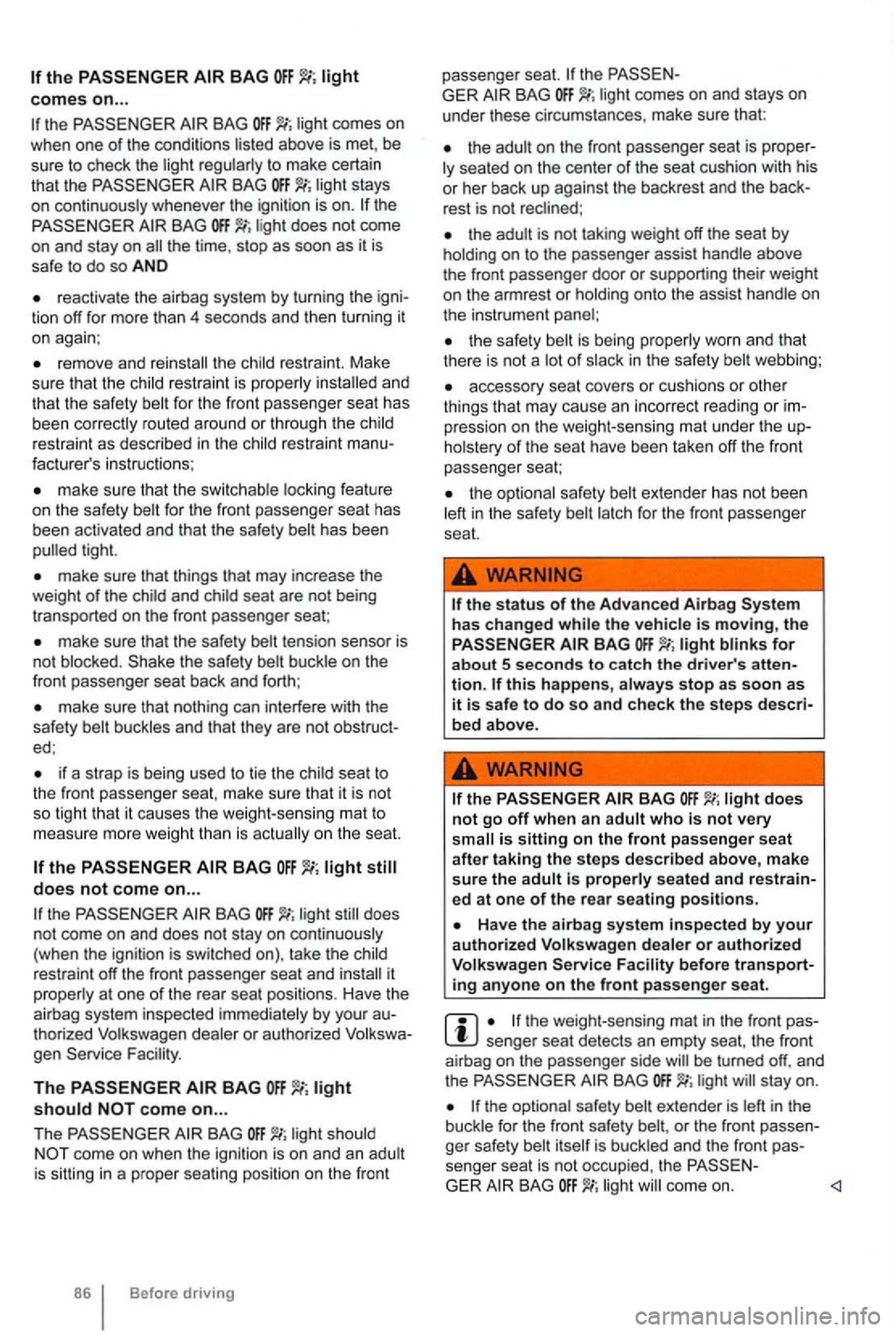
the BAG
to make certain
tha t the light stays
on continuously whenever the ignition is on.
BAG the time , stop as soon as it is safe to do so AND
reactivate the airbag system by turning the tion off for more than 4 seconds and then turning it
on again ;
remove and
facturer 's instruc tions ;
make sure t hat the switchab le locking feature
on the safety
has been
make sure that things that may increase the
weight of the child and child seat are not being
t r ansported on the front passenger seat;
make sure that the safety buck le on the
front passenge r seat back and fort h;
make sure that nothing can interfere with the
safety buckles and that they are not ed;
if a strap is being used to tie the child sea t to the fron t passenger seat, make sure that it is not so tigh t that it cau ses the weight-se nsin g mat to
measure more weight tha n is on th e seat.
light does not come on ...
the ligh t does
not come on and does not stay on continuously
(when the ignition is switched on). take the child
rest raint off the front passenger seat and
it
properly at one of the rear seat posi tions . Have the
airbag system in spec ted immedia te ly by your thorized Facil ity .
The light should come on ...
The
BAG ligh t should
BAG light comes on and stays on
under these circumstances , make sure that:
the adult on the front passenge r seat is seated on the center of th e seat cushion with his
o r her back up against the backrest and the
the
the safety is being properly worn and that
there is not a of slack in the safety webbing;
accessory seat cove rs or cushions or othe r things th at may cause an incorrect read ing or
holstery of the seat have been taken off the front
passenge r seat;
the optional safety in th e safety
for ab out 5 seconds to ca tc h the drive r's atten-tion.
the light does not go off when an adult who is not very is sitti ng on th e front passenger seat
afte r t aking the s teps describ ed above, m ake
s u re the adult i s properly sea te d and re strain-ed at on e of the rear sea ting positions.
H ave t he a irbag syst e m ins pecte d by your
authorize d
senger se at dete cts an empty seat, the front
airbag on the passenger side
light
the optional safety extender is in the
buckle for the front safety or the front ger safety senger seat is not occupied , the BAG light come on.
Page 187 of 516

When an airbag deploys , fine dust is released.
This is normal and is not caused by a fire in the hicle . This dust is made up mostly of a powder
used to lubricate the airbags as they deploy. This
dust could irritate skin and eyes and cause
ciently when used with properly worn safety belts
and a proper seating position in Introduct ion on page 58
equipment
Your safety and the safety of your passenge rs
shouldn't be left to c hance. Advances in
gy have made a number of featu res availab le to
help reduce the risk of injury in a collision . The
Sophisticated safety belts for
belt pretensioners for driver and front
passenger .
Advanced front airbag system for driver and
front passenger .
ger.
Airbag indicato r
BAG light.
Electronic control unit and associa ted sensors.
Before driving
Head restraints with height adjustmen t
Adjustable steering column.
LATCH/U CRA lower universal and top tether
anchorages for child safety seats at the rear
These features
can't work as a system if they are not always
be tu rned
off if the weight on the front passe nger seat is less
than the amount programmed in the elect ronic
con t
rol unit . Th e front airbag on the passenge r side
will also be turned off if the combine d weigh t of an
i nfant
of about one year of age in one of the child
seats that was used to certify the Advanced Airbag
ard BAG
Never rely on airbags alone for protection.
69, Safety belts.
ery per son in the vehicle is properly seated on a sea t of his or her own, properly fastens the safety belts belonging to that seat before the vehicle starts to move, and keeps the belts properly fasten ed while riding i n the hicle. This applies eve n when just driving around town. Therefore, always wear your safety belts and make sure that everybody in your vehicle is properl y restrai ned .
too close to the steering wheel or strument panel decrease the ness of the airbags and will increase the risk of personal injury in a collision.
Page 188 of 516
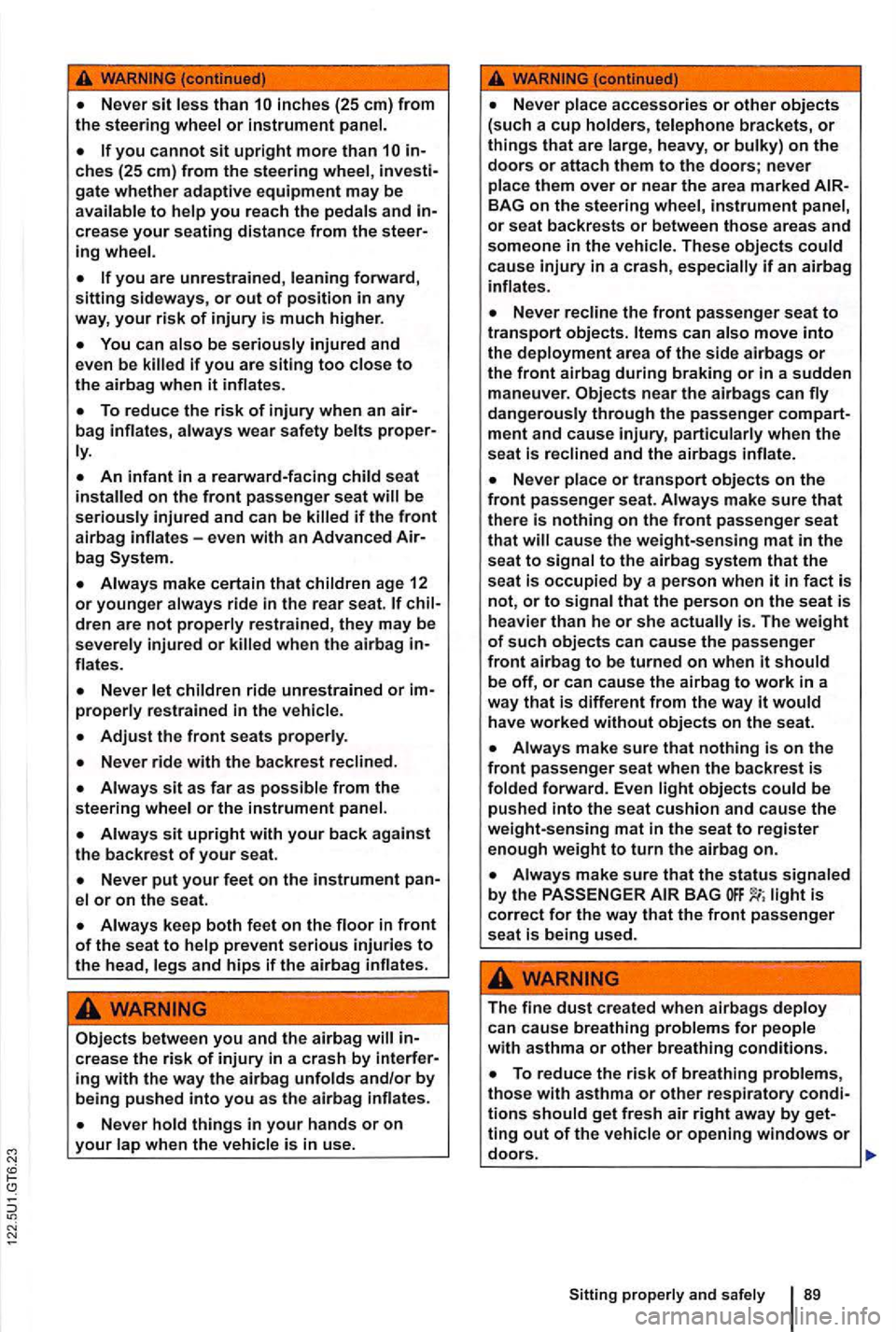
or instrument
you cannot sit upright more than ches (25 em) from the steering gate whether adaptive equipment may be to you reach the and
you are unrestrained ,
be seriously injured and
even be if you are siting too
bag wear safety
if the front airbag inflates -even with an Advanced bag
make certain that children age 12 or younger ride in the rear seat.
when the airbag
sit as far as possible from the steering
sit upright with your back against the backrest of your seat.
prevent serious injuries to the head , legs and hips if the airbag inflates.
Objects between you and the airbag crease the risk of injury in a crash by ing with the way the airbag and/or by being pushed into you as the airbag
when the is in use.
instrument or seat backrests or between those areas and someone in the vehicle. These objects if an airbag inflates.
or transport objects on the front passenger seat. make sure that there is nothing on the front passenger seat that to the airbag system that the
seat is occupied by a person when it in fact is not, or to is. The weight of such objects can cause the passenger front airbag to be turned on when it should be off, or can cause the airbag to work in a
way that is different from the way it have worked without objects on the seat.
make sure that nothing is on the front passenger seat when the backrest is
The fine dust created when airbags
To reduce the risk of breathing problems, those with asthma or other respiratory tions should get fresh air right away by or opening windows or
Page 190 of 516
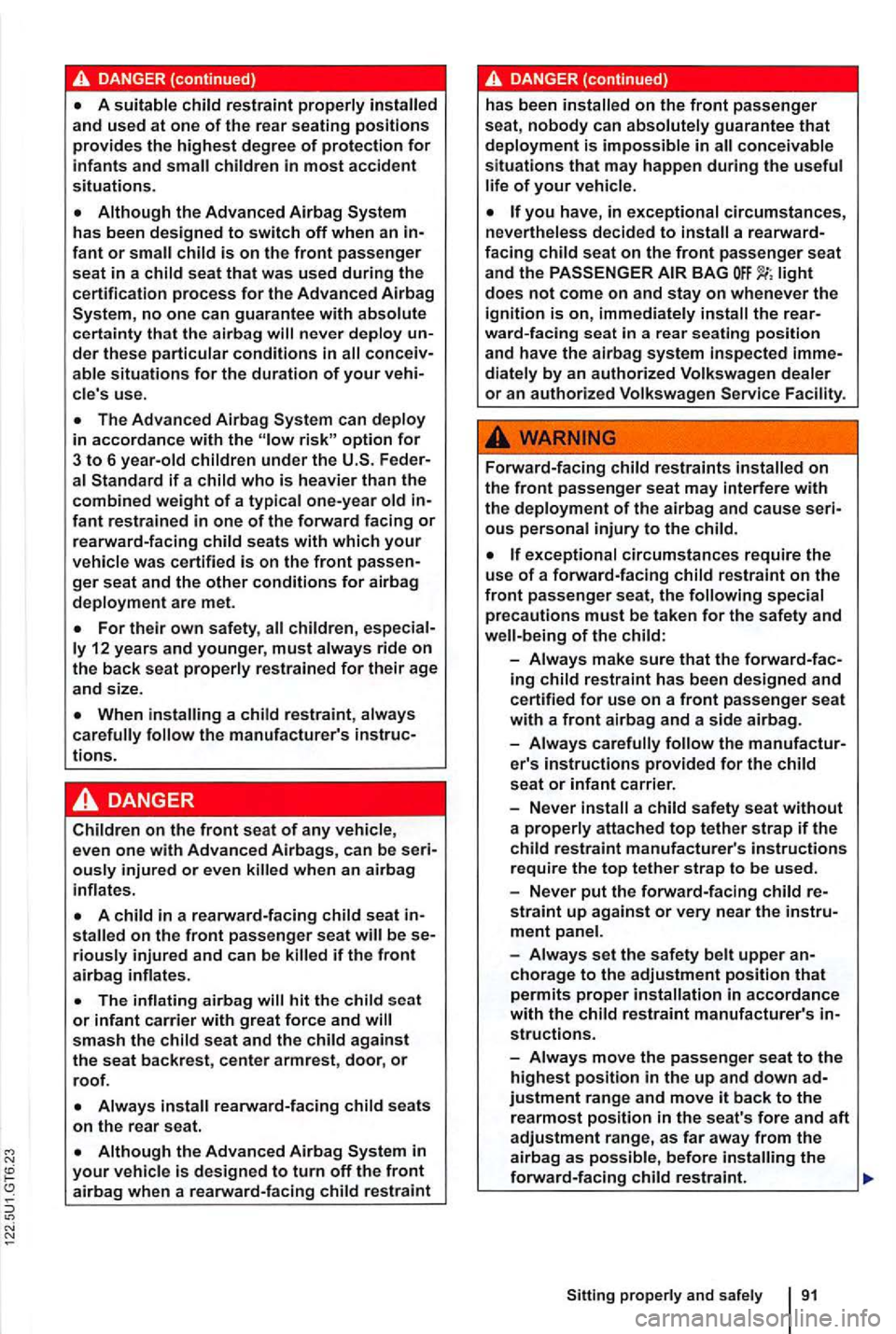
no one can guarantee with absolute certainty that the airbag never deploy
can deploy in accordance with the option for 3 to 6 year-old children under the if a child who is heavier than the combined weight of a typical one-year old fant restrained in one of the forward facing or rearward-facing seats with which your vehicle was certified is on the front passenger seat and the other conditions for airbag deployment are met.
on the front passenger seat if the front airbag inflates.
smash the child seat and the child against the seat backrest, center armrest, door, or roof.
conceivable situations that may happen during the useful life of your vehicle.
light does not come on and stay on whenever the ignition is on, immediately
ous personal injury to the child.
exceptional circumstances require the use of a forward-facing child restraint on the front passenger seat, the following special precautions must be taken for the safety and of the child:
-Always make sure that the forward-facing child restraint has been designed and certified for use on a front passenger seat with a front airbag and a side airbag.
-
Always carefully the manufacturer's instructions provided for the child seat or infant carrier.
- Never
straint up against or very near the instrument panel.
-
Always set the safety belt upper chorage to the adjustment position that permits proper installation in accordance with the child restraint manufacturer's
Sitting properly and safely 91